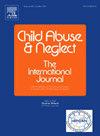Dimensions of childhood trauma and identity disturbance in male adolescents: Examining affected experiences and mediating cognitive functions
IF 3.4
2区 心理学
Q1 FAMILY STUDIES
引用次数: 0
Abstract
Background
Childhood trauma is a major risk factor for identity disturbance, with evidence indicating that cognitive functioning may mediate these effects. Differentiating trauma types and their associated cognitive mediators can deepen understanding of identity development and may guide more effective therapeutic interventions.
Objective
To explore how distinct dimensions of childhood trauma relate to identity disturbance, emphasizing the potential mediating role of cognitive functions.
Participants
The sample comprised 311 male adolescents (Mage = 16.95 years) recruited through convenience sampling from high schools in Yazd, Iran.
Methods
Participants completed the Childhood Trauma Questionnaire, Cognitive Abilities Questionnaire, and Assessment of Identity Development in Adolescence. The study employed path analysis to test the proposed model.
Results
Sexual abuse showed a direct effect on identity disturbance. Emotional neglect and physical abuse predicted identity disturbance both directly and indirectly through cognitive mediators, whereas physical neglect and emotional abuse influenced identity exclusively via cognitive mechanisms. Significant mediators included inhibitory control (β = 0.10, p < .009), decision-making (β = 0.19, p < .001), sustained attention (β = 0.07, p < .003), and social cognition (β = 0.25, p < .001). The model demonstrated adequate fit indices (CFI = 0.99, RMSEA = 0.08).
Conclusions
The results highlight the complexity of identity formation pathways, with distinct patterns of association across trauma types and cognitive functions. By differentiating these domains within an underrepresented cultural context, this study enhances conceptual clarity and advances understanding of mechanisms linking trauma and identity disturbance, offering insights for future research and potential clinical applications.
男性青少年的童年创伤和身份障碍的维度:检查受影响的经历和中介认知功能。
背景:童年创伤是身份障碍的主要危险因素,有证据表明认知功能可能介导这些影响。区分创伤类型及其相关的认知介质可以加深对身份发展的理解,并可能指导更有效的治疗干预。目的:探讨儿童创伤的不同维度与身份障碍的关系,强调认知功能的潜在中介作用。参与者:样本包括311名男性青少年(年龄16.95岁),通过方便抽样从伊朗亚兹德的高中招募。方法:被试完成《童年创伤问卷》、《认知能力问卷》和《青少年认同发展量表》。本研究采用通径分析对模型进行检验。结果:性侵对身份障碍有直接影响。情绪忽视和身体虐待均通过认知机制直接和间接预测身份障碍,而身体忽视和情绪虐待仅通过认知机制影响身份障碍。结论:研究结果突出了身份形成通路的复杂性,在创伤类型和认知功能之间具有不同的关联模式。通过在代表性不足的文化背景下区分这些领域,本研究增强了概念清晰度,并推进了对创伤和身份障碍之间联系机制的理解,为未来的研究和潜在的临床应用提供了见解。
本文章由计算机程序翻译,如有差异,请以英文原文为准。
求助全文
约1分钟内获得全文
求助全文
来源期刊

Child Abuse & Neglect
Multiple-
CiteScore
7.40
自引率
10.40%
发文量
397
期刊介绍:
Official Publication of the International Society for Prevention of Child Abuse and Neglect. Child Abuse & Neglect The International Journal, provides an international, multidisciplinary forum on all aspects of child abuse and neglect, with special emphasis on prevention and treatment; the scope extends further to all those aspects of life which either favor or hinder child development. While contributions will primarily be from the fields of psychology, psychiatry, social work, medicine, nursing, law enforcement, legislature, education, and anthropology, the Journal encourages the concerned lay individual and child-oriented advocate organizations to contribute.
 求助内容:
求助内容: 应助结果提醒方式:
应助结果提醒方式:


